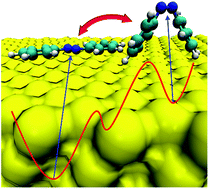Finding the true pathway for reversible isomerization of a single azobenzene molecule tumbling on Au(111) surface†
Abstract
Switchable trans–cis isomerization of azobenzene (AB) and its derivatives on metallic surfaces have offered rich possibilities to functionalize molecular devices. However, the lack of a good understanding of the isomerization pathway has severely limited our ability for rational design. One of the long-debated issues is the cis configuration of the parental AB on the Au(111) surface, for which the experimentally inferred structure differs from the theoretically predicted global minimum. Here, we theoretically identify a new in situ metastable configuration for cis-AB on Au(111) that can reproduce all the observations reported in the scanning tunneling microscopy experiments. It reveals that the bistability of AB on the Au(111) surface is attributed to the significantly increased kinetic stability of the newly discovered cis-AB isomer. A fascinating tumbling pathway that overcomes two energy barriers stimulated by tunneling electrons for the trans–cis AB isomerization on Au(111) has been verified, suggesting a new type of molecular motion based on the AB systems.



 Please wait while we load your content...
Please wait while we load your content...